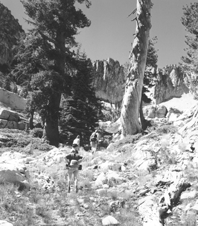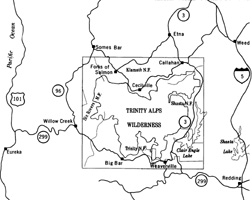
by Tim Martin

Climb to Mirror Lake. (Photo courtesy of Winged Boot)
In last month's Journal, I wrote about the hedonistic pleasures of recreational vehicle travel -- hot tubs and VCRs, air conditioning and blenders. But if a motor home isn't your idea of getting away from it
The Trinity Alps Wilderness Area has it all: 585,000 acres of rugged beauty, 821 lakes and ponds, 50 mountain peaks and 550 miles of trail and cross-country routes. The meadows are a mass of wildflowers -- red paintbrushes, white angelica, and blue and purple lupines. The granite chutes on the mountain rims resemble their cousins, the Swiss Alps, and the canyons are filled with conifers, streams and pristine lakes tucked into rock bowels. On the map, the contour lines of the area look like someone grabbed a fistful and twisted them into one massive Gordian knot.
My sons and I have backpacked into the Trinity Alps for a number of years. We've hiked on boulder-strewn trails, swam in crystalline lakes and camped in grassy meadows that were greener than any green in a Crayola box. We've taken photographs that would easily qualify for postcards. Summer sojourns into the Alps have become a hallowed tradition in our family. all, strap on a backpack and escape to the nearby Alps.

U.S. Forest Service map of Trinity Alps Winderness
When planning a backpacking trip it's important to choose your destination with care. Study guide books and area maps, obtain necessary permits, and limit your hike to a distance you are comfortable with.
For example, a good hike for beginners is the two-and-a-half miler to Boulder Lakes. The distance is short and the 1,000-foot increase in elevation won't leave anyone too exhausted to enjoy the scenery.
Boulder Lakes is an ideal destination for families as well. There are plenty of campsites at the lake, and the fishing is always excellent.
To get to Boulder Lakes take Highway 299 to Weaverville, then left on Highway 3 to Coffee Creek Road, 40 miles north of Weaverville. Drive 10 miles on Coffee Creek Road to the Boulder Lakes trailhead.
A good intermediate hike in the Trinity Alps is the one to Canyon Creek Lake. This lake is nine miles in and the climb is about 3,500 feet (400 feet a mile). The hike is not one you would want to take small children on. But if your child is 8 to 10 years old and can carry a small pack, this might be a good choice. Many Boy Scouts from the Bay Area hike into Canyon Creek Lake each year. The scenery is great, but the trail can often be crowded in the summer.
The Canyon Creek trailhead can be reached by taking Highway 299 to Junction City, 8 miles west of Weaverville. At Junction City, turn onto Canyon Creek Road (marked by a green city street sign). Follow the road 13 miles to the trailhead.
One of the tougher hikes in the Trinity Alps is to Grizzly Lake. Situated on the northern boundary of the Alps, Grizzly Lake is difficult to reach, completely uncrowded and accessible by two trails:
From the North Fork trailhead it is an 18-mile hike to Grizzly Lake. The trail is good and the elevation gain is fairly moderate (4,650 feet) and gently sloping. Most people break this hike up into two days.
A second -- and more strenuous -- route to Grizzly Lake is to approach it from the north from China Creek. This seven-mile hike climbs 5,500 feet and is recommended for seasoned backpackers only. Most people camp below Grizzly Lake. From there, it's another 1,000-foot climb up the lake itself.
To get to the China Creek Trailhead, take Highway 299 to Willow Creek, turn north on Highway 96, west on Highway 93, and south on South Fork Road. Continue to the China Creek Road for six miles to the trailhead.
The North Fork trailhead is accessible by taking Highway 299 to Helena, 15 miles west of Weaverville. Immediately west of the North Fork bridge, turn up East Fork Road and proceed 17 miles, following signs to Hobo Gulch and the trailhead.
Most of the trails in the Trinity Alps are open by now in all but very heavy snow areas and remain so until late October to early November. All trailheads, with the possible exception of Tangle Blue Creek, can be reached by car.
To avoid dehydration while hiking, carry plenty of water. Summer temperatures often exceed 90 degrees. In the lower canyons, temperatures can climb as high as 110 degrees. Evenings, however, require warm clothing. Day-to-night temperature differentials can fluctuate as much as 45 degrees. Other common problems include poison oak, snakes (rattlesnakes have been seen above 9,000 feet) and hyperventilation. First-aid kits are highly recommended.
Elevations in the Trinity Alps look like the top of the world, but are actually 5,000 to 6,000 feet, much lower than the Sierra Nevada or the Rocky Mountains. The result is more terrestrial productivity than in the Sierra. There is more soil, more trees, more lake algae and more insect hatches -- which adds up to large mountain-bred rainbow trout. Fishing is generally good in the Trinity Alps. On many lakes it's not difficult to limit out daily.
For some people there's not enough ketchup on the planet to make freeze-dried food edible, but for others it's the only way to travel. Not only is it lightweight, it's easy to prepare. Companies like Natural High, Richmoor and Backpacker's Pantry offer a wide variety of entries: fettucini alfredo, lasagna, spaghetti marinara, beef stroganoff and chocolate fudge mousse, to name a few.
If you're starting out on a five-day trip and want to save weight, mix in one or two days worth of freeze-dried food with your regular supplies. Other lightweight favorites are instant refried beans, instant soups, instant coffee and hot cocoa, nature burger mix, pasta and oatmeal.
Several cases of the intestinal disorder giardia have been reported in the Trinity Alps. To protect against this disease it is recommended that you treat, filter or boil all water. There are several treatment and filter-type devices on the market which remove giardia bacteria and other matter.
For lightweight, inexpensive weather protection in the mountains, remember to pack rain gear. Another less expensive option is to take along several garbage-can liners: one for a coat, another for pants and the third to cover your pack. Garbage can liners are the lightest, cheapest weather protection you can get. You're completely waterproof for less than a dollar.
If you like to backpack without the crowds, it's best to visit the Trinity Alps in late summer or early fall. The weather is a little colder, but the mountains are as quiet as a held breath. For comfortable fall camping, bring along a high-quality sleeping bag and warm clothing, such as polypropylene long johns and polar fleece outer clothing.
For the novice backpacker who craves the company of others, a guided group backpack trip into the Trinity Alps might be best. It can give you a wonderful blend of wilderness and instant camaraderie, wild adventure and skilled leadership. Several local organizations and commercial outfitters offer guided backpacking in the Trinity Alps. Many offer special attention to beginners, including preliminary meetings. Some even have a special theme, such as wildflower or bird study, survival, rock-climbing or even personal growth.
Among those offering guided tours of the Trinity Alps are Humboldt State University's Center Activities and Winged Boot, an all-female group, in Arcata.
Adventure's Edge (822-4673) and HSU Center Activities also rent backpacking equipment.
For more information about guided tours of the Trinity Alps, contact, Center Activities (826-3357); Winged Boot Productions (826-1054); Ammon Packing (916-629-3565); McBroom and Co. (916-462-4617); or contact the Willow Creek Chamber of Commerce (916-629-2693) for other Trinity Alps outfitters and guides.
THE THINGS THEY CARRIED
"Some want to enjoy the great outdoors while not having to give up too many important things in life, like buttered scones, a morning espresso and the Sunday Times. And what they try to do is take civilization with them ..."
Timothy Martin is a heating and ventilation specialist at Humboldt State Unversity when he isn't writing magazine articles.
Comments? E-mail the Journal: [email protected]
The North Coast Journal Table of Contents